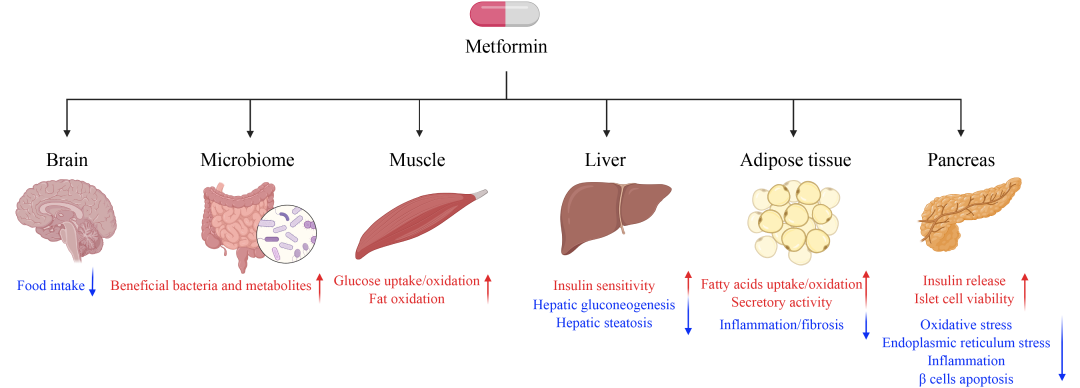导 读
中国科学院上海药物研究所周宇波研究员、臧奕研究员和李佳研究员等在Frontiers of Medicine发表综述论文《二甲双胍在多种疾病中的研究进展及获益》(The development and benefits of metformin in various diseases)。本文全面总结了二甲双胍在多种疾病中的治疗益处,深入探讨了其药代动力学特性、作用机制、治疗策略、临床应用及潜在风险,为进一步研究提供了参考。
Metformin has been used for the treatment of type II diabetes mellitus for decades due to its safety, low cost, and outstanding hypoglycemic effect clinically. The mechanisms underlying these benefits are complex and still not fully understood. Inhibition of mitochondrial respiratory-chain complex I is the most described downstream mechanism of metformin, leading to reduced ATP production and activation of AMP-activated protein kinase (AMPK). Meanwhile, many novel targets of metformin have been gradually discovered. In recent years, multiple pre-clinical and clinical studies are committed to extend the indications of metformin in addition to diabetes. Herein, we summarized the benefits of metformin in four types of diseases, including metabolic associated diseases, cancer, aging and age-related diseases, neurological disorders. We comprehensively discussed the pharmacokinetic properties and the mechanisms of action, treatment strategies, the clinical application, the potential risk of metformin in various diseases. This review provides a brief summary of the benefits and concerns of metformin, aiming to interest scientists to consider and explore the common and specific mechanisms and guiding for the further research. Although there have been countless studies of metformin, longitudinal research in each field is still much warranted.
二甲双胍因其安全性高、成本低廉且临床降糖效果显著,数十年来一直被用于治疗II型糖尿病。其获益机制较为复杂,尚未完全阐明。最常被描述的二甲双胍下游机制是抑制线粒体呼吸链复合物I,导致ATP生成减少,并激活AMP活化蛋白激酶(AMPK)。与此同时,许多新的二甲双胍作用靶点逐渐被发现。近年来,多项临床前及临床研究致力于拓展二甲双胍在糖尿病以外的适应证。本文总结了二甲双胍在四类疾病中的获益,包括代谢相关疾病、癌症、衰老及年龄相关疾病、神经系统疾病,全面探讨了二甲双胍在各类疾病中的药代动力学特性、作用机制、治疗策略、临床应用及潜在风险。本综述简要概括了二甲双胍的获益与潜在问题,旨在激发科研人员思考并探索其共同及特异性机制,为后续研究提供指导。尽管已有大量关于二甲双胍的研究,但各个领域仍亟需深入开展纵向研究。

原文信息
标题
The development and benefits of metformin in various diseases
作者
Ying Dong1, Yingbei Qi1,5, Haowen Jiang1, Tian Mi1, Yunkai Zhang1,2, Chang Peng1,2, Wanchen Li1,2, Yongmei Zhang1,5, Yubo Zhou1,7, Yi Zang1,3,5, Jia Li1,2,4,5,6
机构
1. State Key Laboratory of Drug Research, Shanghai Institute of Materia Medica, Chinese Academy of Sciences, Shanghai 201203, China
2. University of Chinese Academy of Sciences, Beijing 100049, China
3. Lingang Laboratory, Shanghai 201203, China
4. Open Studio for Druggability Research of Marine Natural Products, Pilot National Laboratory for Marine Science and Technology (Qingdao), Qingdao 266237, China
5. School of Pharmaceutical Science and Technology, Hangzhou Institute for Advanced Study, University of Chinese Academy of Sciences, Hangzhou 310024, China
6. Shandong Laboratory of Yantai Drug Discovery, Bohai Rim Advanced Research Institute for Drug Discovery, Yantai 264117, China
7. Zhongshan Institute for Drug Discovery, Shanghai Institute of Materia Medica, Chinese Academy of Sciences, Zhongshan 528400, China
通讯作者
Yubo Zhou, Yi Zang, Jia Li
来源: Engineering前沿


 科普中国公众号
科普中国公众号
 科普中国微博
科普中国微博

 帮助
帮助
 Engineering前沿
Engineering前沿 
